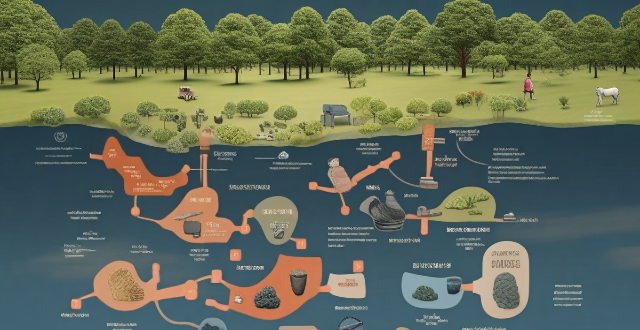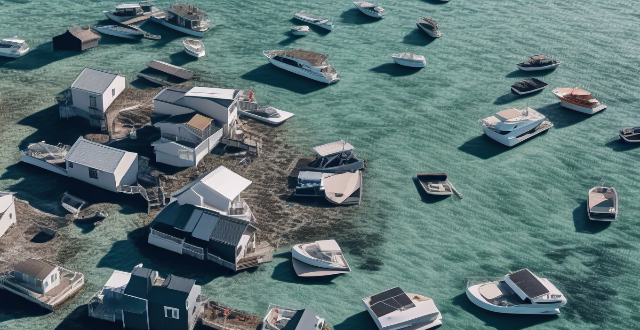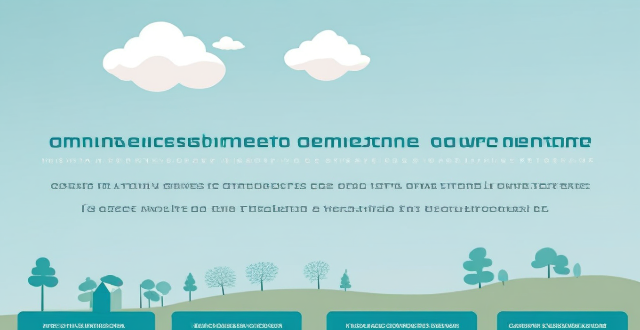Change Damage

Can we prevent climate loss and damage ?
This topic summary discusses the challenges and potential solutions to preventing climate loss and damage, which are negative impacts of climate change on natural and human systems. It highlights the scientific consensus on climate change, irreversible changes already underway, and differential impacts on various regions and communities. The summary then explores mitigation efforts such as reducing greenhouse gas emissions through energy transition, efficiency improvements, and forestry management, as well as carbon capture and storage technology. It also discusses adaptation strategies like building resilience through infrastructure updates, agricultural practices, coastal protection, community-based adaptation, local knowledge, and capacity building. International cooperation is emphasized through global agreements, financial support, and technology transfer. Lastly, individual actions such as lifestyle changes, advocacy, education, and awareness are mentioned as crucial components in minimizing further damage caused by climate change.

How does climate loss and damage affect vulnerable communities ?
The text discusses the impact of climate loss and damage on vulnerable communities. It highlights that these impacts are multifaceted and can be categorized into various sectors including health, agriculture, infrastructure, and social stability. The health impact includes direct and indirect risks from extreme weather events and disruptions to food and water security. The agricultural impact involves crop failures due to changes in precipitation and temperature patterns, leading to loss of livelihoods and increased food prices. Soil degradation also reduces land productivity. Infrastructure damage includes coastal erosion and inland flooding, causing property loss, disruption of services, and repair costs. Social stability is affected by displacement due to environmental changes and economic strain from adapting to climate change. The conclusion emphasizes that addressing these challenges requires global cooperation and targeted support to build resilience and protect those most at risk.

How can we measure the extent of climate loss and damage ?
Measuring the extent of climate loss and damage requires a comprehensive approach that considers various factors, including direct and indirect impacts on natural and human systems. To measure these impacts, we need to identify affected areas, quantify economic losses, assess social and health impacts, evaluate environmental impacts, and consider long-term implications. By doing so, we can better understand the scope of climate loss and damage and develop effective strategies for adaptation and mitigation.

What are the ethical implications of climate loss and damage ?
The ethical implications of climate loss and damage are multifaceted, involving issues of justice, responsibility, human rights, and intergenerational equity. Those who have contributed the least to climate change are often disproportionately affected by its consequences, raising questions about fairness and justice. Responsibility and accountability for addressing these impacts are also crucial, with industrialized nations having historically emitted more greenhouse gases and generally having more resources to invest in climate action than poorer ones. Climate loss and damage pose serious threats to human rights, including the right to life, health, food, water, and housing. Intergenerational equity is also a significant consideration, as current generations must not deprive future generations of the ability to meet their own needs by depleting natural resources and altering the climate system. Addressing these challenges requires global cooperation and a commitment to creating a more equitable and sustainable world for all current and future inhabitants of our planet.

What is climate loss and damage ?
Climate loss and damage refer to the negative impacts of climate change on natural and human systems, including direct impacts such as extreme weather events and sea-level rise, and indirect impacts such as ecosystem changes and food security issues. Mitigating these impacts involves reducing greenhouse gas emissions and adapting to the inevitable effects of climate change.

How does climate change cause losses and damages ?
Climate change causes losses and damages in various ways, including environmental impacts such as extreme weather events, sea level rise, and biodiversity loss; societal impacts such as health risks, food security issues, and water scarcity; and economic impacts such as infrastructure damage, increased insurance costs, and labor market disruptions. Addressing these challenges requires coordinated efforts to mitigate greenhouse gas emissions and adapt to the changing climate.

How can I prepare my home for an earthquake to minimize damage ?
Earthquakes are natural disasters that can cause significant damage to homes and properties. However, there are several steps you can take to prepare your home for an earthquake and minimize the potential damage. Some tips include securing large appliances and furniture, reinforcing your home's structure, securing plumbing and gas lines, and preparing for aftershocks. By following these tips, you can help minimize the damage caused by an earthquake and protect yourself and your family.

Can I use homemade cleaners on electronic devices, or will they cause damage ?
Homemade cleaners are cost-effective and environmentally friendly, but using them on electronic devices can be risky. Some homemade cleaners, like vinegar and lemon juice, are acidic and can damage sensitive parts of electronic devices. Others, like baking soda, are abrasive and can scratch surfaces or leave a residue behind. Commercial cleaners, on the other hand, are specifically designed for electronic devices and are tested for safety. Therefore, it is recommended to use commercial cleaners on electronic devices to ensure their safety and longevity.

How does climate change affect education ?
Climate change impacts education through extreme weather events, health issues, food insecurity, economic challenges, social changes, and environmental degradation. These effects necessitate collaboration between educators and policymakers to develop resilient strategies for adapting to climate change.

How can we adapt to the losses and damages caused by climate change ?
Climate change has already caused significant losses and damages, including extreme weather events, rising sea levels, and changes in precipitation patterns. To adapt to these impacts, we need to take proactive measures at individual, community, and governmental levels. Some strategies for adapting to the losses and damages caused by climate change include understanding the risks, strengthening infrastructure, promoting sustainable practices, building community resilience, encouraging innovation and research, supporting policy initiatives, fostering international cooperation, investing in natural solutions, preparing for long-term changes, and integrating adaptation into development goals. By implementing these strategies, we can build a more resilient society capable of adapting to the losses and damages caused by climate change.

How does climate change impact national security ?
Climate change impacts national security in various ways, including economic disruption, social unrest, and political instability. To mitigate these effects, it is essential to take action at both the national and international levels, such as reducing greenhouse gas emissions, investing in renewable energy sources, and adapting to the inevitable changes brought about by climate change.

How does climate change affect the construction industry ?
Climate change affects the construction industry in various ways, including increased extreme weather events leading to damage and costly repairs, changes in building codes and standards due to new environmental conditions, a focus on energy efficiency and sustainability, potential disruptions to labor availability and supply chains, and increased insurance costs. Builders and developers must adapt by embracing new technologies and practices that promote sustainability and resilience.

What are the economic impacts of climate loss and damage ?
The article discusses the economic impacts of climate loss and damage, including direct impacts on agriculture, coastal communities, and health, as well as indirect impacts on the energy sector, insurance and financial services, and the labor market. It highlights the need for a comprehensive approach to address these challenges.

What are the potential consequences of ignoring climate change ?
The text discusses the potential consequences of ignoring climate change, including environmental effects such as extreme weather events and loss of biodiversity, economic disruptions like damage to agriculture and infrastructure, public health issues including the spread of diseases and heat-related illnesses, and social impacts such as forced migration and reduced quality of life. It emphasizes the importance of addressing climate change to avoid these catastrophic implications for our planet and all life on it.

What are the long-term consequences of climate loss and damage ?
The article discusses the long-term consequences of climate loss and damage, including rising sea levels, extreme weather events, loss of biodiversity, impact on agriculture, disruption of industries, costs of mitigation and adaptation, health risks, displacement and migration, and impact on culture and heritage. It highlights the need for a global effort to reduce greenhouse gas emissions and adapt to the changing climate in order to create a more sustainable future.

What are the economic consequences of climate change ?
The article discusses the economic consequences of climate change, including its impact on agriculture, tourism, energy, and infrastructure. In agriculture, decreased crop yields, loss of biodiversity, and increased extreme weather events can lead to higher food prices and reduced agricultural income for farmers. In tourism, loss of natural attractions, changes in seasonality, and health risks can result in reduced tourism revenue for affected regions. In energy, increased demand for cooling systems, disruption of energy production facilities, and transition to renewable energy sources can create new economic opportunities but also require significant investment and adaptation. In infrastructure, damage to critical infrastructure like roads, bridges, and buildings can result in costly repairs and replacements for governments and private sector organizations. Addressing these challenges requires coordinated action by governments, businesses, and individuals to reduce greenhouse gas emissions and adapt to the changing climate.

How does climate change disproportionately affect marginalized communities ?
This essay discusses how climate change affects marginalized communities, including low-income populations, indigenous people, and residents of coastal areas. It explains why these communities are more vulnerable to the effects of climate change and provides examples of how they are affected. The essay concludes that addressing these disparities requires targeted interventions that prioritize the protection and empowerment of marginalized communities.

What role do governments play in addressing climate loss and damage ?
Governments play a critical role in addressing climate loss and damage through legislation and policy making, research and development, education and awareness, and international cooperation. They can enact laws that regulate emissions and protect natural resources, develop policies that encourage sustainable practices, fund research into new technologies for reducing greenhouse gas emissions, launch public education campaigns to raise awareness about climate change, and work together through international agreements and collaborative projects to share knowledge and resources. By taking these actions, governments can help mitigate the effects of climate change and protect our planet for future generations.

How does climate change influence nutrition and dietary health through changes in food production ?
Climate change affects nutrition and dietary health by altering food production, impacting crop yields, nutrient content, pest and disease pressure, and the availability and accessibility of food. Sustainable agricultural practices and adaptation are crucial for mitigating these effects and ensuring global food security.

What is the relationship between climate loss and damage and food security ?
The article discusses the complex relationship between climate loss and damage and food security, highlighting how extreme weather events and slower changes in climate can impact food production. It details the consequences of these impacts for food security, such as reduced crop yields, increased prices, loss of livelihoods, nutritional impacts, and displacement. The article also suggests mitigation and adaptation strategies to address this issue, including reducing greenhouse gas emissions, sustainable agriculture practices, crop diversification, improved irrigation systems, early warning systems, and research and development. The conclusion emphasizes the need for collective action to ensure food security in the face of climate change.

How does climate change affect the fishing industry ?
Climate change affects the fishing industry through changes in water temperature, ocean acidification, extreme weather events, changes in fisheries management policies, and economic impacts. These factors can lead to overfishing, reduced fish populations, damage to infrastructure and equipment, disruption of natural habitats, and decreased profitability for fishermen. To address these challenges, sustainable management practices and international cooperation are necessary to ensure the long-term viability of the fishing industry.

What are the potential impacts of climate change on different sectors ?
Climate change affects various sectors differently. In agriculture, changes in crop yields, shifts in planting seasons, increased pest and disease pressure, and water scarcity may occur. Health issues include heat-related illnesses, spread of diseases, air quality problems, and mental health concerns. Economic impacts involve job losses, infrastructure damage, supply chain disruptions, and investment risks. Environmental effects encompass loss of biodiversity, ocean acidification, deforestation, and sea level rise. It is crucial for all stakeholders to take measures to mitigate these impacts and adapt to the changing climate.

How does climate change influence job security in coastal regions ?
Climate change significantly impacts job security in coastal regions through direct effects such as sea level rise, increased storm intensity, and changes in ocean temperatures. These environmental changes directly affect industries like fishing, tourism, agriculture, and infrastructure, leading to job losses or reduced hours for employees. Indirectly, climate change can cause economic displacement, public health concerns, and policy changes that create new job opportunities while potentially reducing jobs in other sectors. Addressing these challenges requires coordinated efforts from various stakeholders to adapt to changing conditions and transition towards more resilient economic systems.

What are the impacts of climate change on human health ?
Climate change affects human health in various ways, including increased heat-related illnesses, extreme weather events, changes in disease patterns, food and water security issues, and mental health impacts. It is important to take action to mitigate these effects and protect public health.

What are the potential risks of climate change for the insurance sector ?
Climate change poses significant threats to the insurance sector, including increased natural disasters, changes in liability exposures, property value fluctuations, and regulatory/legal changes. Insurers must adapt by assessing risks, updating policies, and collaborating with governments to create effective strategies.

What is the impact of climate change on agricultural employment ?
Impact of Climate Change on Agricultural Employment: - Reduced Crop Yields due to droughts, floods, and loss of biodiversity can lead to job losses. - Changes in Cropping Patterns, such as shifting to new crops or shortened planting seasons, may require different skillsets and reduce employment opportunities. - Increased Pest and Disease Pressure can result in more labor for monitoring and management but also potential job losses from crop failures. - Infrastructure Damage and Displacement caused by extreme weather events can affect farming operations and employment levels. - Adaptation and Resilience Efforts, including developing resilient crop varieties and adopting sustainable farming practices, can create new job opportunities.

What is the impact of climate change on children's access to education ?
Climate change affects children's access to education through extreme weather events, health impacts, food security issues, and displacement and migration. These challenges make it difficult for children to attend school or continue their studies. It is crucial to take action now to mitigate the effects of climate change and protect the future of education.

How does climate change affect the environment ?
The article discusses the various impacts of climate change on the environment, including rising temperatures leading to melting glaciers and ice sheets, changes in precipitation patterns causing droughts and extreme rainfall events, and extreme weather events such as heat waves and hurricanes. It also highlights the loss and fragmentation of habitats due to range shifts and coral reef bleaching, as well as the loss of biodiversity through direct effects like species extinction and population declines, and indirect effects like food web disruptions and disease spread. The article emphasizes the need for urgent action to reduce greenhouse gas emissions and implement adaptation strategies to mitigate these impacts on our planet's ecosystems.

What are the benefits of climate resilience ?
Climate resilience is crucial for adapting to climate change impacts and recovering from related damages. It offers economic, social, environmental, political, and cultural benefits. These include reduced damage costs, protection of assets, enhanced productivity, improved public health, community cohesion, continuous education, biodiversity conservation, resource stewardship, reduction of greenhouse gas emissions, increased government legitimacy, international leadership, policy innovation, preservation of heritage, strengthening of cultural practices, and promotion of cultural exchange. Building climate resilience ensures more robust, equitable, and sustainable futures.

How does climate change affect water resources and availability ?
Climate change affects water resources and availability through melting glaciers, changes in precipitation patterns, sea level rise, increased evaporation rates, and impacts on ecosystems. These impacts can lead to water scarcity, flooding, contamination of freshwater sources, and declines in biodiversity. To mitigate these effects, it is important to reduce greenhouse gas emissions and implement adaptation strategies such as improved water management and conservation measures.